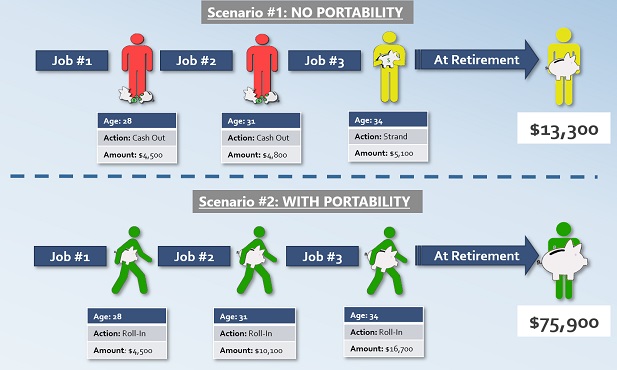 Shorter tenure equals more turnover and more jobs during workers' careers, and more turnover results in an increased incidence of cashout leakage of 401(k) plans. (Photo: Shutterstock)
Shorter tenure equals more turnover and more jobs during workers' careers, and more turnover results in an increased incidence of cashout leakage of 401(k) plans. (Photo: Shutterstock)
On April 10th, the Employee Benefit Research Institute (EBRI) featured the webinar EBriefing: Trends in Employee Tenure, showcasing the latest EBRI research examining broad employee tenure trends over time, and the impact that shorter tenure can have on retirement savings.
The webinar's presenters included Craig Copeland, Senior Research Associate, EBRI and Spencer Williams, President & CEO, Retirement Clearinghouse (RCH), and was moderated by Stacy Schaus, Founder & CEO, Schaus Group LLC.
Craig Copeland on tenure trends
Leading off, EBRI's Copeland detailed the latest trends in employee tenure using data from the U.S. Census Bureau's Current Population Survey, which covers 1983 to present.
Copeland's presentation immediately dispelled two commonly-held myths regarding employee tenure: 1) that a large percentage of individuals hold a “career job” and 2) that tenure tends to be shorter when the labor market is weakest.
Copeland's data also revealed two important findings linking tenure to retirement savings:
- Account balance size is strongly correlated to tenure. The EBRI/ICI 401(k) Plan Database reveals that 28% of active participants with a balance less than $5,000 in 2012 were not in the same plan in 2013, whereas that figure dropped to 21% for participants with a balance between $5,000-$9,999 and to 17% for those with balances $20,000 or more.
- The average and median balances of “consistent 401(k) plan participants” – which includes participation across retirement plans – were significantly higher than the values for all participants.
Copeland summarized the impact of shorter tenure on retirement as follows:
- Shorter tenure equals more turnover and more jobs during workers' careers
- More turnover results in an increased incidence of cashout leakage
- If retirement savings are stranded in a prior plan, coordination with new plan savings may not occur
- Continuous participation in a plan has a large impact on the resulting savings amounts
Spencer Williams introduces “synthetic tenure”
RCH's Spencer Williams then introduced a new concept – “synthetic tenure” – whereby enhancing system-wide portability, particularly for small accounts, enables participants to preserve their savings through job changes, mirroring the success of EBRI's longer-tenured, consistent participation population.
Making the case for synthetic tenure, Williams presented composite cashout leakage statistics, indicating that the preponderance of today's cashout leakage occurs for job-changing participants with plan account balances less than $5,000.
Next, applying EBRI tenure data, Williams illustrated two scenarios for a 25-34 year-old participant, whose average tenure is less than 3 years, and will likely have 3 jobs during that period in their life.
- Without portability: The hypothetical participant will likely cash out two of their three small-balance retirement accounts and leave the third stranded with their prior employer, resulting in $13,300 in retirement savings at age 65.
- With portability: The average participant would likely preserve those three balances, rolling them forward into their new employer's plan. By contrast, they would have a $75,900 balance at retirement, an amount which would simulate the outcomes of the higher-tenured, consistent participation population.
 Figure 1: Synthetic Tenure (Image: Retirement Clearinghouse)
Figure 1: Synthetic Tenure (Image: Retirement Clearinghouse)Once again referencing EBRI research, Williams noted that in 2017, EBRI estimated that system-wide auto-portability would dramatically reduce leakage for small accounts, preserving more than $1.5 trillion in the retirement savings, in today's dollars.
In closing, Williams also noted that auto-portability, once adopted, could lead to a dramatic reduction in the incidence of missing participants by 1) consolidating accounts as participants change jobs and 2) providing a source of more-reliable current address information, when a participant's current-employer's plan can be located and accessed for address information.
Tom Hawkins is Senior Vice President, Marketing & Research at Retirement Clearinghouse.
READ MORE:
What is auto-portability? It depends on who's asking
DOL cracks down on efforts to find missing participants
401(k) truth bomb: Missing participants are bad, but cashouts are worse
© 2025 ALM Global, LLC, All Rights Reserved. Request academic re-use from www.copyright.com. All other uses, submit a request to [email protected]. For more information visit Asset & Logo Licensing.







